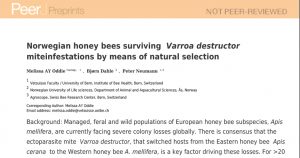It is positive that the research community is becoming increasingly focused on varro-resistant honeybees. The latest report comes from a doctoral student, Melissa Oddie. She has started an investigation why a Norwegian beekeeper’s population of bee colonies can be called resistant because, according to his information, he hasn’t treated his bees against varroa in at least 19 years. Their article is a pre-presentation before it is peer reviewed. It could be read and downloaded here when I was writing this: https://peerj.com/preprints/2976.pdf
The result showed that the varroa population of the test bees had a growth rate of 0.87, ie a decrease over time. While the non-resistant control colonies had a growth rate of 1.24, i.e. an increase of the mite population over time.
Positive details in the study
- One of the beekeeper’s own apiaries was used and its colonies were used in the test.. Thus, no queen was introduced to other types of bees in another place. The resistant bees and their queens were tested in their normal environment.
- The distance between the test and the control colonies were big, 60 km.
Details missing
- The name of the beekeeper. He had earned a place among the authors.
- The beekeeper has exchanged breeding material with another commercial beekeeper since 2004. This beekeeper has also not been treating his bees for many years.
- The number of bee colonies forming the resistant colony population is not mentioned.
- The cell size used by the beekeeper is 4.9 mm, ie small cellsize, for almost as many years as he did not treat against varroa.
- The cell size of the control colonies is also not mentioned. Is it also 4.9 mm or larger?
- It is not mentioned if there are other bees close to the test and control colonies. The test beekeeper has several apiaries. If any of them are near the test apiary, it would probably not affect the test. How many other type of bees could be found near the test and control apiaries (if any) is not mentioned and, if so, the distance to these bees. It is important for the reinvasion risk.
- Nothing is mentioned of annual losses for the years backwards for the test and control colonies. It may be of secondary significance and these figures may also not have been secured. However, some kind of data about of the losses at the beginning of the adaptation of the test bees could have been interesting to take part of. But the article is inspiring anyhow.
- There are also no tips for beekeepers inspired by their article to start developing their bees to become resistant. Of course, it is not a task of the test I understand, but some kind of comment about this has been positive since many beekeepers will certainly appreciate the article and be inspired by it. However, such advice I look forward to find in follow-up articles in bee magazines.

It would also be nice to know what the forage quality and quantity is in the area where these colonies are kept. The main reason colonies fail in USA is that forage quantity is very sparse in most areas. I would even suggest this why queen failures or queen events are so wide spread due to poor diets of natural plant based pollen and nectar. Feeding artificial diets to bees is wide spread in USA because of poor forage.
Do you mean, that bee forage in USA comes only from plants taken from Europe? This might be the reason of poor forage, otherwise you perhaps don’t know what it really is… In the USA there is ca. 4,5mln bee colonies, isn’t it (official USDA data shows only 2,5mln)? And the area is almost 10mln sq. km. There is a big difference between USA and eg. Poland, where on area of ca 0,315mln sq. km lives more than 1,5mln of bee colonies.
Michael Palmer on his lecture on National Honey Show says: “We have poor forage” and then he shows average honey production 50 tonnes per 1000 production colonies. Such amounts are possible in Poland only in migratory apiary.
It strikes me that “To mitigate the global impact of V. destructor, we suggest learning more from nature, i.e. identifying the obviously efficient mechanisms favored
by natural selection” is a pretty obvious conclusion, one that various researchers as well as individual longterm practitioners of treatment-free beekeeping have postulated for a number of years now; various references can be found here http://www.naturalbeekeepingtrust.org/the-science and here http://www.naturalbeekeepingtrust.org/natural-selection
The problem is that all beekeeping is local.
The first years treatment free beekeepers have to evaluate their own situation, decide if it would work to do bond or do some integrated pest managements or have two strategies in different beeyards not to loose too many colonies.
What works in a study`s area and under a study`s circumstances does not work everywhere.
But who is patient like that or accepts to fail once or twice and go on?
If you live in Germany like I do, it´s not possible to expand your apiary with catching feral swarms and it´s not possible to do bond because of the law.
So what´s the most important thing is: to monitor mite infestation and decide the path.
This would be the best strategy not only for treatment free but for treating too.
To treat prophylactically is, in my eyes, the worst scenario to set free the weakest genes possible.
Still this is the common action here. Treat at a special time of year no matter how the mite situation is, not monitoring the results of having treated and multiplying weak colonies, infested by brood disease, distributing the drones.
Even beekeepers who treat should be able and responsible to only breed from their most resistant colonies.